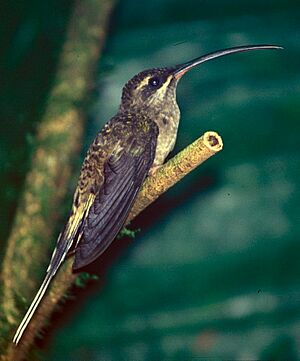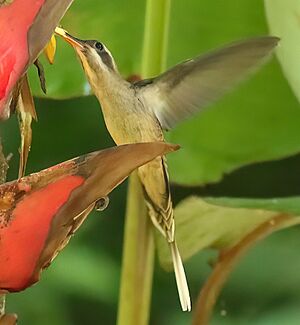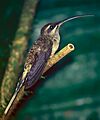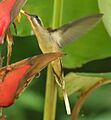Long-billed hermit facts for kids
Quick facts for kids Long-billed hermit |
|
|---|---|
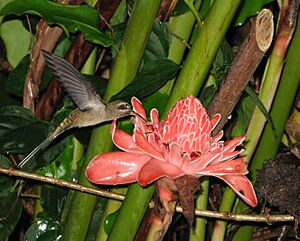 |
|
| Photographed in Drake Bay, Costa Rica | |
| Conservation status | |
| Scientific classification | |
| Genus: |
Phaethornis
|
| Species: |
longirostris
|
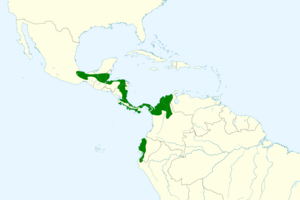 |
|
The long-billed hermit (Phaethornis longirostris) is a type of bird that belongs to the hummingbird family, called Trochilidae. You can find this bird from central Mexico all the way south through Central America, Colombia, and Ecuador, reaching into Peru.
Contents
About the Long-billed Hermit
How Scientists Classify Them
For a long time, scientists thought the long-billed hermit was the same species as the long-tailed hermit (P. superciliosus), which lives east of the Andes mountains. They used to call them "western" and "eastern" long-tailed hermits. But now, after more study, scientists have decided they are two different species.
Most bird experts, like the International Ornithological Committee (IOC), agree that there are four main types, or subspecies, of the long-billed hermit:
- P. l. longirostris
- P. l. cephalus
- P. l. susurrus
- P. l. baroni
However, some groups, like BirdLife International, think that P. l. baroni is its own separate species, which they call the "Ecuadorian hermit." Other scientists have not agreed with this idea.
What They Look Like
The long-billed hermit is a small bird, usually about 13 to 16 centimeters (5 to 6 inches) long. Males weigh between 5 to 7.5 grams (0.18 to 0.26 ounces), and females are a bit lighter, weighing 4 to 6.5 grams (0.14 to 0.23 ounces).
The most common type, P. l. longirostris, has greenish-brown feathers on its back and brownish or grayish feathers underneath. The feathers covering its upper tail have dark and light bands. Its two central tail feathers are quite long and have white tips. This bird has a long, curved beak. Female long-billed hermits have a shorter but more curved beak than the males.
Other subspecies have slight differences:
- P. l. cephalus looks similar but has more yellowish-brown feathers on its belly, especially in the southern parts of its home range.
- P. l. susurrus is larger than cephalus but has similar colors.
- P. l. baroni has dull metallic green feathers on its back and a whiter belly compared to the others.
Where They Live
Long-billed hermits live in different areas depending on their subspecies:
- P. l. longirostris lives from Mexico (in Oaxaca and Chiapas states) south through Guatemala into northern Honduras.
- P. l. cephalus is found from eastern Honduras through Nicaragua, Costa Rica, and Panama, reaching into northwestern Colombia.
- P. l. susurrus lives in an isolated area called the Sierra Nevada de Santa Marta in northeastern Colombia.
- P. l. baroni can be found from western Esmeraldas Province in Ecuador south into Tumbes and Piura departments in Peru.
These birds like to live in the lower parts and edges of many different types of forests. This includes rainforests, older secondary forests (forests that have grown back after being cut down), humid forests that lose some leaves in dry seasons, cloudforests, and gallery forests (forests along rivers). They can be found from sea level up to high elevations, sometimes as high as 2,500 meters (8,200 feet) in northern Colombia.
Behavior and Life Cycle
Movement
Long-billed hermits don't travel long distances. They usually stay in their home areas but might move short distances to find food or mates.
What They Eat
Like other hermit hummingbirds, the long-billed hermit is a "trap-line" feeder. This means it flies along a regular path, visiting many different flowering plants to drink their nectar. Some of their favorite flowers include Heliconia, Costus, Aphelandra, and Passiflora. They also eat small arthropods, like tiny insects or spiders.
Reproduction and Breeding
The breeding season for long-billed hermits changes depending on where they live. For example, in Mexico, they breed from April to July, while in Panama, it's from May to September. In Colombia, it's usually from January to April or May.
Their nest is shaped like a cone and is made from plant fibers and spider silk. They hang it from the underside of a drooping leaf. A female long-billed hermit usually lays two eggs. The eggs hatch after about 17 to 18 days, and the young birds are ready to leave the nest (fledge) about 22 to 23 days after hatching.
During the breeding season, male long-billed hermits gather in special places called leks. A lek is like a singing club where up to 25 males sing together to attract females. They also wiggle their long tails to show off! These singing competitions can last for half of the daylight hours. Older males also have longer beaks, which they might use to defend their spot at the lek from other males.
Their Sounds
The songs of the three northern subspecies (longirostris, cephalus, and susurrus) sound like a continuous series of sharp, rising "sweeup" notes. Their call is a quick, loud "week!" which they often make while flying.
The song of P. l. baroni is different. It's a continuous series of single, chipping notes that sound like a sparrow, "tchee..tchee..tchee..". Its call is a thin "seep," also made while flying.
Conservation Status
The IUCN (International Union for Conservation of Nature) considers the long-billed hermit and the "Ecuadorian hermit" (P. l. baroni) to be of "Least Concern." This means they are not currently in danger of disappearing. However, scientists don't know exactly how many of these birds there are or if their numbers are changing.
One subspecies, P. l. susurrus, lives in a small area, which could put it at risk in the future. On the other hand, P. l. cephalus lives in many protected areas in Costa Rica, which helps keep its population safe. P. l. baroni is quite common where it lives and is also found in some protected areas.
Images for kids



